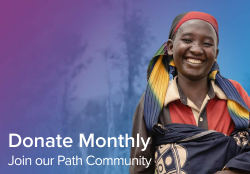Posts Tagged ‘Refugees’
Interview with Office Director: Tami McLaughlin
How did you start working at World Relief?
I was the director of missions at a local church outside of Atlanta and we partnered with World Relief for a short-term mission trip. We went to Clarkston, Georgia, and I think it has the largest number of languages spoken in one square miles in the United States; it was a community that was refugee-based. That was my introduction to World Relief, and when I was looking for a new job I actually applied to World Relief four times. I started out as an employment specialist in Atlanta, and one day my boss walked into my office and said ‘I think you’re from Wisconsin, and we have a position open in Wisconsin.
How do the teachings of Jesus Christ impact what you do at World Relief?
Jesus loves the vulnerable. I think in the Old Testament the words ‘refugee’ and ‘sojourner’ are mentioned over 20 times. I think these people and this work is really dear to God’s heart, and I feel the presence of God has been so evident in so many situations that I’ve been in because of how important this work is to him. Jesus loves, Jesus is involved, Jesus’s presence is present.
What is the biggest cultural difference that you’ve experienced when working with refugees?
When I first started working at World Relief, I was working with three sisters. We’re trying to find a job for them, and two of the sisters got jobs at a chicken factory. The third sister wasn’t strong enough to do the work in the factory. A couple of weeks later, I got a call from the human resource department at the chicken factory and they said ‘You need to tell your clients that if they can’t come to work they can’t send their sister to work in their place.’ To me, it was common sense that you can’t send someone else to work for you, but for them it wasn’t. That was a learning experience for me, how we should evaluate some of the things we do in our own culture.
What should the residents of the Fox Cities know about their refugee neighbors or how they can support them?
They should know that their refugee neighbors will deeply enrich their lives by bringing in a different culture. Different cultures are something that we all could learn from and that would enrich our lives if we took the time to learn about them. I think it is sometimes assumed that when people have a different language or different skills, that they’re not as strong or have as much to contribute to our community. Refugees are people who’ve survived and persevered through really difficult situations, but their circumstances shouldn’t define them. They are very resilient people who have survived so much, and when they’re here they can start thriving beyond any circumstance they’ve had to face.
Was Jesus a Refugee?
“Jesus Was a Refugee.” Recently, I’ve seen that message all over — on billboards, TV ads, on t-shirts, debated on social media and beyond. Much of this messaging is part of a broader campaign called He Gets Us that aims to help people recognize that Jesus was a human being who can identify with us in our humanity.
That’s a powerful reality for the more than 32 million refugees in our world today, a number unprecedented in recorded history. Jesus “gets” them because, early in his human experience, the Gospel of Matthew tells us that he was forced to flee the threat of Herod’s persecution. He was carried by Joseph and Mary to Egypt, beyond Herod’s dominion, where they would be safe from the genocide inflicted by a jealous ruler on the little boys of Bethlehem.
Many of today’s 32 million refugees know viscerally what it means to awaken in the middle of the night and to flee with what little they could carry, as an angel instructed Joseph to do. To feel danger just behind them. To complete a grueling journey only to arrive in a new land and a new culture with the ongoing grief of the loss of one’s homeland. Jesus presumably lived all of that in his fully human flesh as a small child. And millions today find solace in that reality. He gets them.
But was Jesus really a refugee?
We now have formal legal definitions for the term “refugee” in both U.S. and international law: refugees are those outside of their countries of origin who are unable or unwilling to return because of a well-founded fear of persecution on account of their race, religion, political opinion, nationality or membership in a particular social group. But, of course, these definitions did not exist when the holy family made their journey.
Some, especially on social media, have vehemently insisted that Jesus was not a refugee — perhaps defensive at the implication that their preferred refugee and immigration policies to keep most, if not all, refugees out might actually have harmed the incarnate God.
But while it is clear from the biblical text that Jesus was displaced by a credible threat of persecution, it’s fair to ask just how he would fare under our contemporary policies — as theologian Glenn Butner Jr. does in a new book, Jesus the Refugee: Ancient Injustice and Modern Solidarity.
Butner argues that Jesus largely satisfies the contemporary legal definition of a refugee, but it’s debatable whether the journey to Egypt took him “outside of his country of origin,” since Egypt and Bethlehem were both part of the Roman Empire. Perhaps it’s more precise to characterize the holy family as “Internally Displaced Persons” — those, including more than 60 million people in our world today, who have been forced to flee their homes but remain within the boundaries of their countries.
Would Jesus have faced the barriers many families fleeing persecution face today?
Perhaps Jesus was actually an asylum seeker: asylum seekers profess to meet the definition of a refugee. They say that they’re afraid of persecution on account of one of the enumerated grounds — but they’re not ensured protection under the law unless and until they have demonstrated (to the satisfaction of the governing authorities of the country where they hope to find refuge) that they indeed qualify. Sometimes they lack documentary evidence of the credibility of their fear. Would Joseph have cited an angelic message as his evidence that persecution was likely for little boys in Bethlehem? Would that have satisfied an Egyptian immigration judge?
Fortunately for our Lord and Savior and his earthly parents, there’s no evidence in the biblical text that they faced any barriers to finding refuge in Egypt. But the Gospel of Matthew gives us very few details about their experience there. We’re left to speculate: were they welcomed, seen as a potential threat or simply ignored? Did Jesus learn to speak his first words with a different accent than his parents? Did Joseph easily find work, or was he told that he would be “stealing” a job from an Egyptian carpenter?
Decades later, in one of his final sermons before his crucifixion, Jesus commends certain individuals for having welcomed him when he was a stranger. The disciples are confused: “When did we see you a stranger and invite you in, or needing clothes and clothe you?” (Matthew 25:38). They did so, Jesus says, when they welcomed one of “the least of these brothers and sisters of mine” (Matthew 25:40). Jesus identifies himself perpetually with the vulnerable and the stranger — which, at least early in his life, he himself was.
Does Jesus’ story shape how we respond to refugees and other immigrants?
Whether Jesus would satisfy the precise legal definition of a refugee or not, what’s clear for those of us who profess to follow him today is that an unprecedented crisis of forced migration — with more than 100 million people forced from their homes, experiencing displacement similar to what Jesus experienced as a child — presents an unprecedented opportunity to demonstrate love for Jesus himself.
At World Relief, it’s our great privilege to partner with local churches both across the United States and in various other parts of the world to welcome and care for refugees and others who have been displaced. From our U.S. refugee resettlement program’s foundations in the 1970s, we — and the tens of thousands of church-based volunteers who have partnered with us — have resettled more than 300,000 individuals, motivated by Jesus’ challenging words in Matthew 25. As Evelyn Mangham, the cofounder of World Relief’s refugee resettlement program said, the Christian response to an unprecedented global refugee crisis is “simple”:
“Respond to what Jesus said, that’s all: ‘I was hungry, and you gave me something to eat. I was thirsty and you gave me something to drink. I was a stranger’ — refugee — ‘and you took me in… Inasmuch as you did unto of the least of these my brethren, you did unto me.’ It’s simple obedience.”
Are you ready to create a more welcoming and just world for refugees and other vulnerable immigrants? Learn how you can join us today.

Myal Greene has a deep desire to see churches worldwide equipped, empowered, and engaged in meeting the needs of vulnerable families in their communities. In 2021, he became President and CEO after serving for fourteen years with the organization. While living in Rwanda for eight years, he developed World Relief’s innovative church-based programming model that is currently used in nine countries. He also spent six years in leadership roles within the international programs division. He has previous experience working with the U.S. Government. He holds B.S. in Finance from Lehigh University and an M.A. from Fuller Theological Seminary in Global Leadership. He and his wife Sharon and have three children.
9 Things You Need to Know About Private Sponsorship
This blog was updated on June 21, 2023.
On January 19th, the Biden Administration announced a new private sponsorship program for refugees called The Welcome Corps. Through the Welcome Corps, everyday Americans can directly sponsor refugees who are being resettled in the U.S.
Since this blog was first published, the Welcome Corps has designated World Relief as an official Private Sponsorship Organization, opening new opportunities for us to equip Americans sponsoring refugees outside the current geographic locations of our U.S. offices.
Today, there are an estimated 103 million displaced people globally, including 32.5 million refugees. Forced from their homes and separated from support networks, refugees are among the world’s most vulnerable populations.
At World Relief, we know you want to live out Jesus’ call to welcome the stranger and care for those experiencing vulnerability. Private sponsorship builds on World Relief’s existing opportunities that engage local communities in welcoming newcomers and is one more way you can answer that call. Here are 9 things you should know about private sponsorship and how you can get involved.
1. What is the Welcome Corps?
The Welcome Corps is a new private sponsorship program from the U.S. government that allows groups to sponsor and resettle refugees. Sponsors will play a key role in welcoming, supporting and assisting refugees as they rebuild their lives in the U.S. and integrate into their new communities.
2. How do I become a sponsor?
Becoming a private sponsor is a multi-step process that includes forming a group of five or more individuals, submitting an application, background checks, demonstrating sufficient financial resources and more. Currently, private sponsors can apply to be matched with someone in need of sponsorship. The U.S. government is also working to roll out an option for people to sponsor specific individuals they already know who are in need of resettlement from another country.
Those interested in partnering with World Relief in private sponsorship can fill out the form below to receive more information. All Private Sponsorship Groups will be required to go through the Welcome Corps’ application and vetting process, which you can begin at any time on the Welcome Corps website.
3. Who is eligible for resettlement through the Welcome Corps?
This new program will be implemented in two phases. In its first year, the Welcome Corps’ goal is to mobilize at least 10,000 Americans to welcome refugees primarily from countries in Sub-Saharan Africa, and then scale up to make the program an enduring feature of the refugee resettlement system.
In the second phase of the program (which is not yet active), private sponsorship groups will be able to identify specific refugees whom they wish to sponsor. For more information on eligibility, visit the Welcome Corps website.
4. If I become a sponsor, what will I do?
Sponsors assume responsibility for initial resettlement services, providing financial and other forms of support as required by the refugee resettlement process. Some examples of non-material support include:
- Meeting the refugee(s) upon arrival in the United States and transporting them to initial housing
- Ensuring that the sponsee has safe and appropriate housing and basic necessities
- Ensuring that the sponsee’s healthcare and medical needs are met for the duration of the resettlement period
- As appropriate, helping the sponsee complete the necessary paperwork for employment authorization, a Social Security card and for any other public benefits for which they may be eligible
- As appropriate, assisting the sponsee with accessing education, learning English and enrolling children in school
- Supporting employable sponsees in securing employment in the U.S. workforce
- Ensuring appropriate interpretation/translation
- Providing cultural and community orientations
For more information on the sponsorship process and what’s required of sponsors, visit the Welcome Corps website.
5. Is private sponsorship good for refugees?
Private sponsorship opens more pathways for more people fleeing persecution to rebuild their lives and thrive. At World Relief, we applaud the expansion of sustainable, lawful opportunities for those fleeing persecution to find safety in the U.S.
Navigating the process of private sponsorship can also come with challenges for both sponsors and refugees. But you don’t have to face them alone.
At World Relief, we have decades of experience working with refugees and displaced populations across the globe through our various local community sponsorship and volunteer programs. We utilize this experience to equip churches and passionate people like you to walk alongside those who choose to welcome newcomers and the newcomers they are matched with.
If you are interested in private sponsorship or connecting with one of our U.S. locations, and would like to receive updates on how World Relief can support you in the process, please sign up here. In addition, we will send you a free code for our eLearning course “Navigating Friendships” which will help you learn how to build empowering, long-lasting friendships with those from different cultures.
6. Has private sponsorship been done elsewhere?
Yes! Private sponsorship has been a successful piece of refugee resettlement efforts in countries like Canada and Australia, and versions of private sponsorship have even been part of U.S. refugee resettlement historically. Most recently, the U.S. has re-engaged private sponsorship models to resettle people from Afghanistan, Ukraine, Venezuela, Haiti, Nicaragua and Cuba. This new program goes beyond existing private sponsorship programs providing a pathway to resettle refugees from around the world.
7. What about traditional pathways to refugee resettlement? Will refugees continue to be resettled by World Relief and other agencies?
Yes! The U.S. federal refugee resettlement program will continue to operate and World Relief will continue to offer various ways for churches and individuals to engage in welcoming refugees and other immigrants in vulnerable situations. Private sponsorship will complement the work already being done by organizations like World Relief, allowing more people fleeing persecution to find safety in the U.S.
8. Is World Relief assisting with private sponsorship?
On June 13, the Welcome Corps announced World Relief as an officially designated Private Sponsorship Organization. This will allow us to use our decades of experience and expertise to equip even more church and community groups who are eager to extend welcome outside the geographic locations of our U.S. offices. We will also continue to provide other community sponsorship opportunities — such as our Good Neighbor Team program — through our local U.S. office locations.
What’s more, we have resources already available to serve both sponsors and those being sponsored. The World Relief Workshop is our e-learning platform designed to equip individuals, groups and churches to best serve their refugee neighbors — from courses on navigating common barriers to ESL tutoring. Many of our U.S. offices are also able to offer services to sponsees such as English classes and immigration legal services.
*To receive updates on World Relief’s involvement with private sponsorship + a free Workshop course, sign up here.
9. I’m not ready to become a private sponsor. Is there anything else I can do?
Yes! As mentioned, World Relief works with refugees and displaced people in the U.S. and all over the world and offers the opportunity to welcome and walk alongside refugees and other immigrants through local volunteer and sponsorship programs.
You can support this work by volunteering at a local office in your area or making a donation to World Relief. Your gift will allow us to provide job training, legal support and more for immigrants and refugees in the U.S. as well as respond to the needs of people in places like Ukraine, South Sudan and DR Congo. Together, we can extend welcome and address the root challenges that lead to displacement in the first place.
Churches in Washington are Using Coffee to Change the Lives of Refugees and Immigrants
If you’ve been to Western Washington, you know that coffee is a big deal. Seattle consistently ranks near the top of “best coffee cities in America.” One analysis even found there are 56 coffee shops for every 100,000 people.
Coffee is such a big deal, in fact, that many local churches have fully outfitted coffee shops to meet the caffeine needs of Sunday morning guests. But what if those coffee shops could serve an even bigger purpose — what if they could help welcome refugees and immigrants?
That’s the question Holly Andrews asked herself when she moved to Washington in 2011.
The Seed of an Idea
Holly’s interest in welcoming refugees and immigrants started when she tutored a Somali family in college through World Relief. “It was such a great adventure getting to know [the family’s] culture and language, sharing food together and growing in a trusting relationship,” Holly said.
Inspired by this family’s story and a growing awareness of her refugee and immigrant neighbors, Holly went on to become a teacher for English language learners, eventually completing her masters in linguistics.
Later, while working at Bethel University in Minnesota, she led a study-abroad course in Cambodia where the seed of an idea was planted.
One of the agencies she and her students visited ran a cafe where they provided job training for women survivors of trafficking. “I loved that [the program] gave women a chance to work with dignity and demonstrated the grace of God by meeting them where they were at,” Holly said.
She felt so moved that she even hoped to return to Cambodia to help with the cafe program. But, “God had different plans.”
Barista Training for Newcomers
Shortly after returning from Cambodia, Holly and her husband moved to Washington, and Holly began working at World Relief. She also started attending Calvary Chapel South in Kent. The church had a coffee shop, which reminded her of her time in Cambodia.
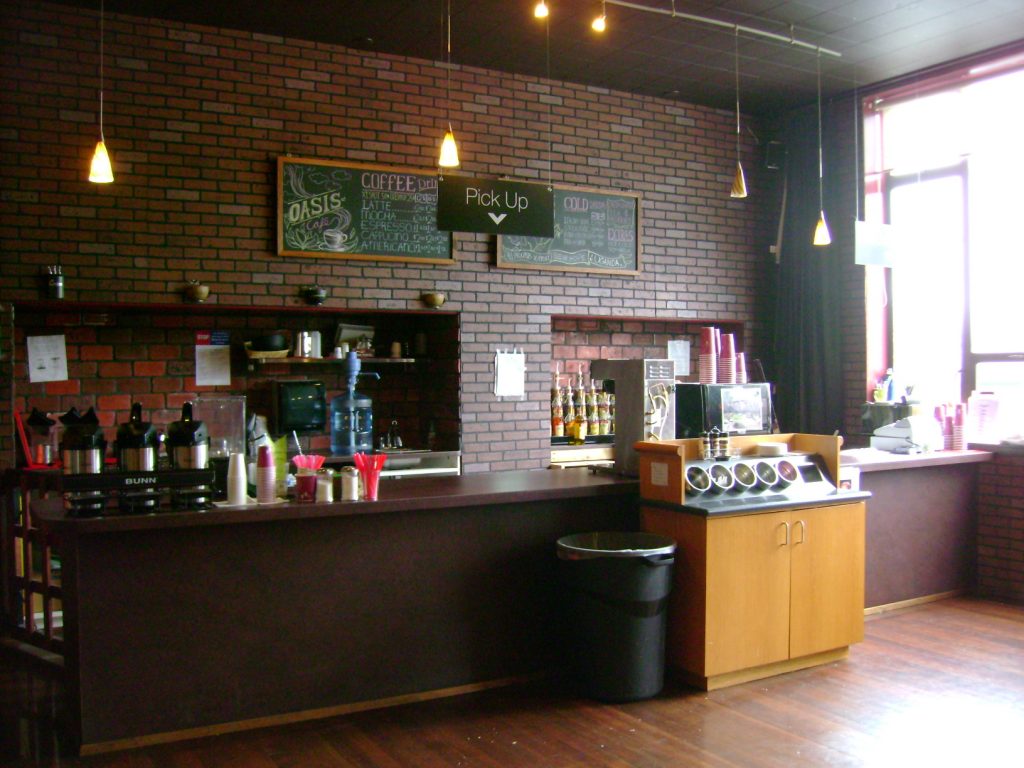
“I thought, wow, this would be a really neat opportunity to partner together — the church and World Relief — and provide some practical training [to refugees].”
Within a year, Holly helped Calvary Chapel South launch a barista training program for newly arrived refugees and immigrants. Since then, Holly has also launched the training program at Brooklake Church in Federal Way, where she now works as the Outreach Director.
Both churches partner with World Relief Western Washington’s Employment Services to identify and refer participants to the programs. So far, the two churches have trained more than 25 refugees.
More Than a Training Program
Much like the Cambodian cafe that first inspired Holly, the barista program in Washington is designed to meet each participant’s individual needs. Focusing on only a few students at a time, training sessions are tailored based on the trainee’s prior work experience and English level.
Participants are enrolled in a 12-week program that takes place every Sunday while church coffee shops are up and running. Each week, participants focus on learning how to run one aspect of the coffee shop, while also practicing their English and customer service skills.
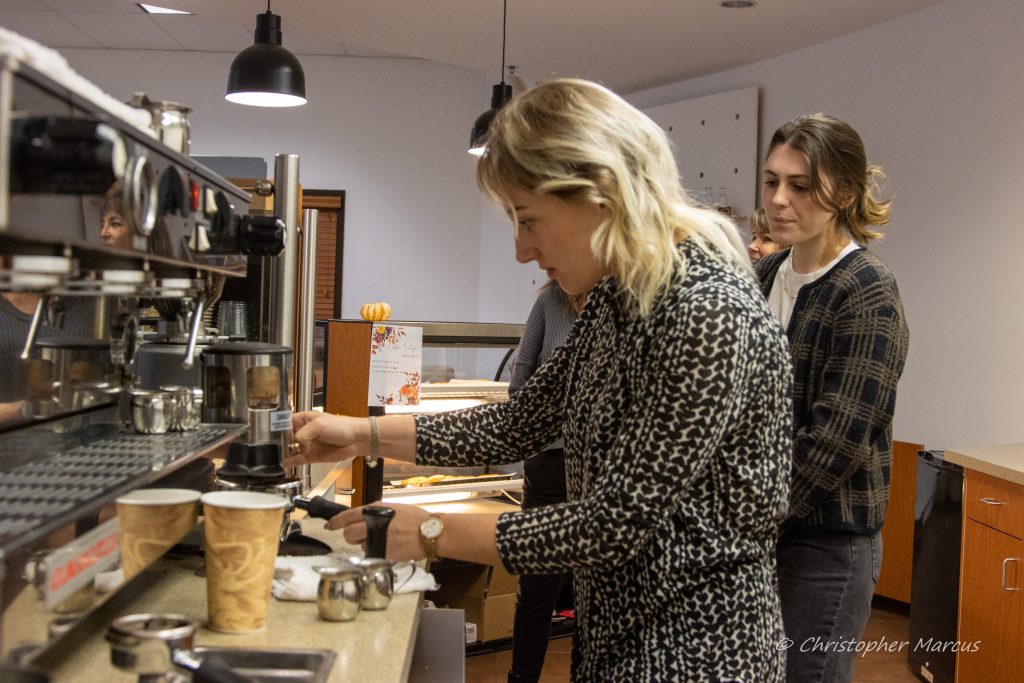
But there’s more to the program than barista skills and English — there’s an opportunity to form friendships. Tutors intentionally leave space for navigating culture and offering encouragement, advice and even prayer when appropriate.
“The churches don’t just help our participants learn new skills,” said Santa Pradhan, Employment Program Manager at World Relief Western Washington. “They also welcome them with open arms and give them a sense of community.”
As tutors help trainees feel like “less of a stranger,” trainees help tutors expand their understanding of refugees and immigrants and clarify misperceptions. “Our participants have been instrumental in helping the church to be better at following God’s call for us to welcome the stranger,” Holly said.
As participants and volunteers become invested in one another’s lives, many form friendships that last long beyond the end of the program.
Careers Beyond Coffee
This was the case for Hawraa. After resettling in the U.S. from Iraq, she joined the barista training program in early 2016. Today, Hawraa remains friends with Holly and the volunteers from Calvary Chapel South’s coffee shop training, and she credits the program with teaching her more than barista skills. She also learned customer service and how to interact with others in a U.S. workplace, lessons that would carry her career beyond the coffee shop.
“[The barista program] was the first thing that I participated in that was close to a job when I first came to the United States. It prepared me for bigger things that I went on to do,” she said.
Hawraa is now working as a case manager with Puget Sound Training Center, helping other refugees, immigrants and under-served populations achieve career success in the U.S.
When asked what advice she would give to U.S. churches hoping to welcome refugees and immigrants, she said, “Please offer them participation in programs and events, help them as much as possible with their English since most are too embarrassed to make mistakes, and just smile! Seeing smiling, welcoming faces was one of the best things when coming to the United States.”
Why the Church?
Like World Relief, Holly believes the church is called to embody the hope of Jesus in the midst of a hurting world. One of the ways churches in the U.S. can do that is by welcoming new immigrants into their communities and seeking to learn from one another.
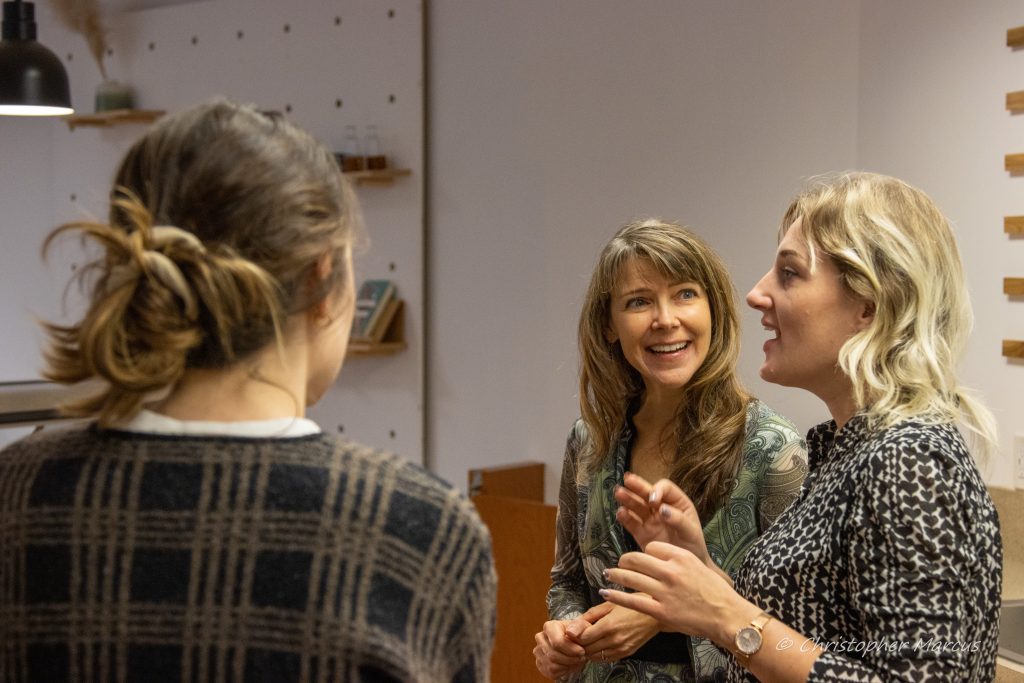
“We see in the establishment of the early church, God’s design… is for people to come together, pour over his Word and to fellowship with one another in a deep and devoted way,” she said. “How amazing when the local church can enfold newcomers into this kind of community.”
For churches not yet connected with refugees and immigrants, Holly suggests first discovering who is already providing services for refugees and immigrants, including established immigrant communities. Work together to determine how best to be a supportive partner in the resettlement process.
She also recommends taking note of what your church already has that might help in welcoming someone who has recently arrived in the U.S.
While not every church has a full coffee shop, others may have shuttles available to provide transportation to local thrift stores or markets, or business owners from local churches might host a small job fair. English tutoring, access to computers, job search assistance and fun after-school activities can also make a big impact.
But most importantly, Holly emphasizes the value of friendship as we seek to create more welcoming communities where everyone can thrive.
“The church can first and foremost be a friend,” she said. “Rest from ‘doing’ and leave room for just being together, sharing life and learning from one another. Be hospitable and accept hospitality. This is a ministry in itself.”
Want to be a part of creating lasting change for refugees, immigrants and people experiencing vulnerability around the world? Learn how we’re moving forward together.
If your church is ready to dive deeper into how best to love and welcome your refugee and immigrant neighbors, check out The Workshop, World Relief’s e-learning platform. Use code CHURCH25 for 25% off through January 31, 2023.
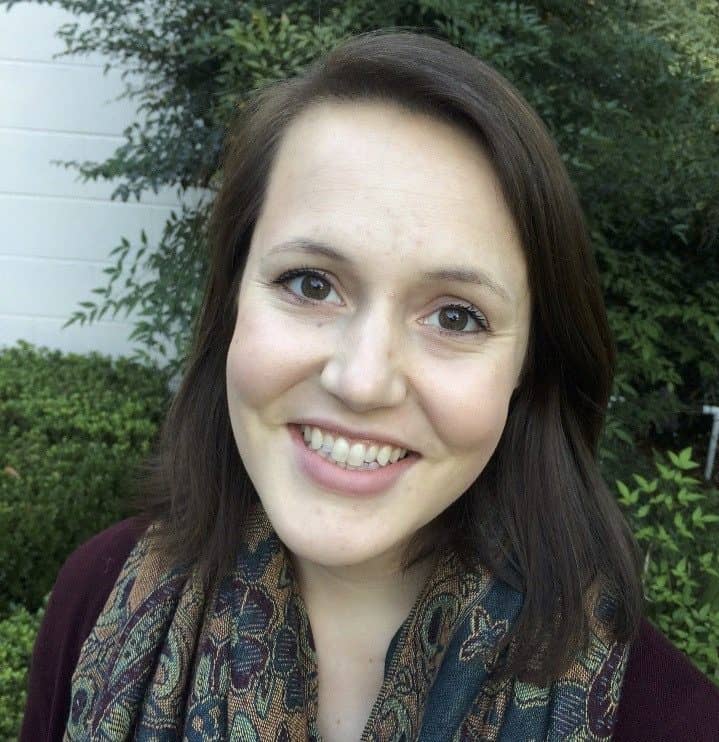
Kelly Hill serves as a Content Writer at World Relief and previously served as Volunteer Services Manager at World Relief Triad in North Carolina. With a background in International and Intercultural Communication, she is passionate about the power of story to connect people of diverse experiences.
Resiliency & Hope in the Midst of Persecution
Fleeing Persecution in Cambodia
When Sithy and his wife, Saobot, arrived in the United States in March of 2022, he was not sure what his life would look like. He had been rejected, persecuted, and imprisoned for his political affiliation in Cambodia.
Both Sithy and Saobot’s siblings and other family members remain in Cambodia. While they do not have any relatives here in the United States, they have already found solace in his neighbors – both those who partner with World Relief Triad and the Cambodian community that surrounds them.
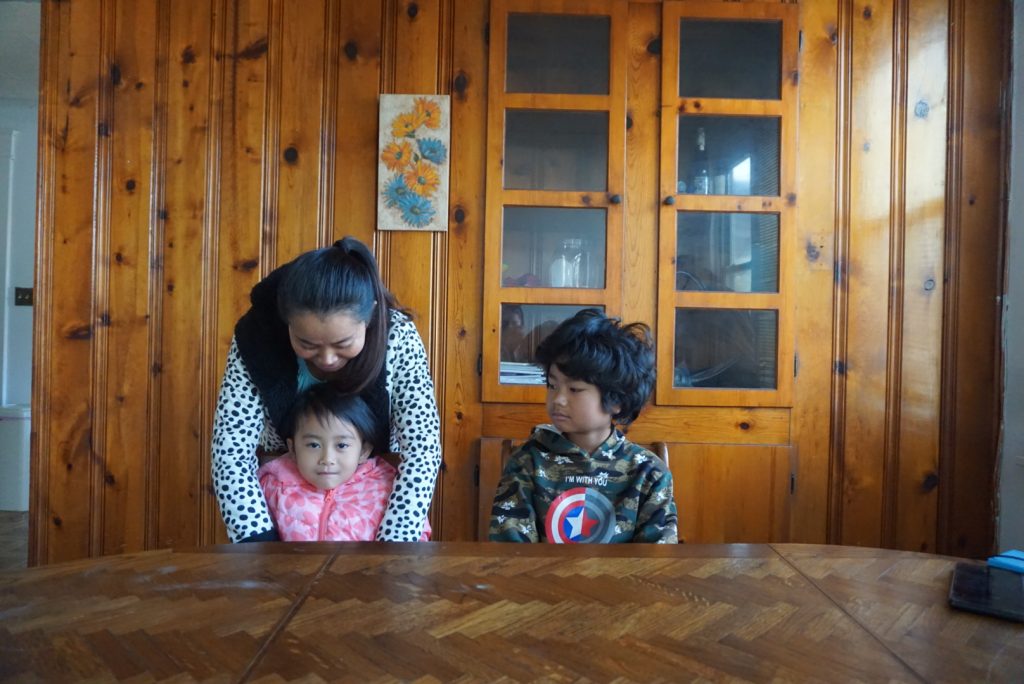
“My friends from the Cambodian community know my story of why I’m an immigrant,” Sithy says. “I’m a refugee because of political issues. When I was in Cambodia, I was captured and put in prison. They were pressuring me to live there. After I fled to Thailand, people followed me and tried to capture and kill me.”
He recalls the way that it felt to finally be in Thailand but not in full safety yet. “When I left Cambodia, I didn’t have any hope,” Sithy says.
“When I was leaving Thailand, I had even less hope. I felt like I was floating in the middle of the sea.”
Finally, when Sithy arrived in the United States with his wife and children, he gained a hope that he had never thought possible. “Right now, I’m happy,” he says. “I have freedom with the hope that I live in a democratic country like the United States.”
Life After Arriving in the U.S.
It is no wonder that Sithy “hit the ground running” once he finally was able to begin his life in the United States. Within weeks of adjusting to his new home, Sithy began working for two different people. He also received some extra funding from World Relief which covered some of his rent and utilities easing the burden of housing costs.
With the money saved, combined with the money given to him by friends in the local Cambodian community, Sithy was able to pay for his first car. Now that Sithy has hope and stability in his life here in the Triad, he has already begun to make plans for his family.
“For myself, I need to find permanent work,” he says. “I know I will have help from World Relief and the community in the process of finding the right job for myself and my wife. I want her to continue her studies, and I plan to try and meet the GED requirements because the certificate I have from Cambodia isn’t eligible here without a high school degree.”
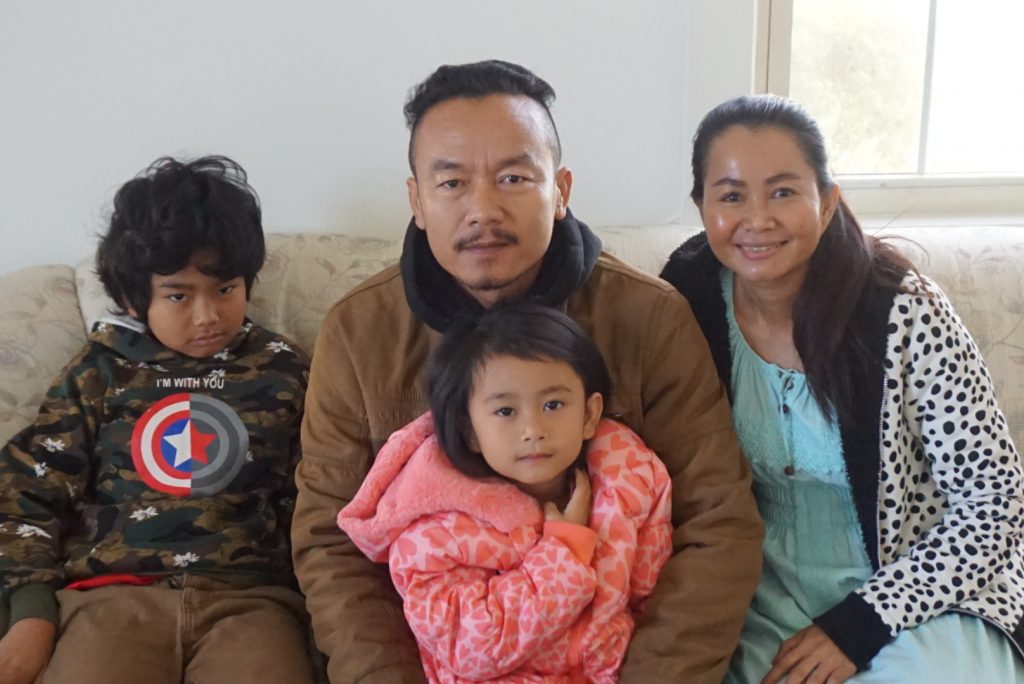
Sithy can now use his own car to transport himself and his wife to various ESL classes, personal appointments, and eventually their future places of employment! Because of supporters like you, World Relief Triad was able to ease housing costs through locally raised funds, giving newcomers like Sithy the ability to pay for and provide his own transportation for himself and his family.
Let’s Go Together for Those Who Have Yet to Come
Over the past two years, our office has faced many challenges. In the midst of a global pandemic, a new administration led to a large influx of arrivals which forced our office to ramp up in staff members, an ongoing war in Ukraine, and the fall of Kabul which ultimately led to thousands of Afghans being forced to flee their home country. Yet, our community remained to be a sanctuary for the displaced.
We invite you to join us as we cast a new vision, together, as we go forward into the reality of an uncertain future. When you give today, you join World Relief Triad in going further than we’ve ever previously dreamt possible.
Together, we can welcome more, like Sithy and Saobot, into a world of restored hope, peace, security and joy.
Liberty and Justice for All: A Citizenship Story
On September 17, U.S. Citizenship and Immigration Services invites “Americans to reflect on the rights and responsibilities of citizenship and what it means to be a U.S. citizen” as part of an annual Citizenship Day observance. This year, we’re celebrating citizenship and the stability it can bring to those who have been displaced by sharing Aimee’s story.
For the first 24 years of her life, Aimee had no citizenship at all. Born as a refugee in the Republic of Congo and resettled in the U.S. at the age of 15, living without citizenship felt like a continual search for permanence — until July 2, 2022 when she became a naturalized U.S. citizen. Finally, Aimee has a country to call her own!
On the World Relief Western Washington blog, Aimee shares what citizenship means to her and how she plans to use her new nationality to continue serving displaced people around the world.
Do you want to help more people like Aimee Pave the Path to a brighter, more secure future? Whether helping displaced people rebuild their lives, building peace in divided communities or finding sustainable solutions for families impacted by climate change, you can be a part of creating lasting change around the world when you join The Path, our community of monthly givers.
5 Ways to Keep Welcoming Afghans
In August 2021, the U.S. military withdrew from Afghanistan, and Kabul fell to the Taliban. Many Afghans, especially those who had assisted the U.S. government, were left at considerable risk. Since the withdrawal, an estimated 84,600 Afghans have been evacuated to the U.S.
Over the last year, people like you have helped us welcome 3,419 of those Afghans. World Relief staff, volunteers, church partners and donors have given generously of their time, friendship and resources to help these families and individuals begin rebuilding their lives.
Within weeks of the fall of Kabul, churches were gathering household supplies to transform empty apartments into homes for Afghan arrivals. Volunteers formed Good Neighbor Teams to help Afghan families adjust to life in the U.S. And, even as they began rebuilding their own lives, leaders emerged from the Afghan community to help us better welcome our new neighbors.
Now, we invite you to keep leaning in. Do not grow weary of doing good — the work of welcome doesn’t stop when headlines fade.
Here are 5 ways you can keep building a movement of welcome for Afghans in the U.S. By continuing to advocate with, pray for and walk alongside Afghans, you can embody Christ’s love for all people, whether or not they’re making headline news.
1. Ask Congress to provide lasting protection for evacuated Afghans
Many of the Afghans evacuated to the U.S. were granted entry as “parolees.” This means their immigration status is temporary, leaving tens of thousands of Afghan women, men and children resettled in the U.S. with uncertain futures.
Take action today on behalf of your Afghan neighbors by emailing Congress and urging them to support the Afghan Adjustment Act, which will provide lasting protection to evacuated Afghans in the U.S.
2. Learn about Afghan culture to better connect with your Afghan neighbors
As Afghan evacuees continue to rebuild their lives in the U.S., you may find yourself wondering — How can I better connect with and serve my Afghan neighbors?
In the Afghan Culture Guide, an interactive, online course from the World Relief Workshop, we share essential knowledge about Afghan culture, unpack common tension points and provide practical tools to help move you towards a mutually enriching friendship with your Afghan neighbors. Now through September 30, enroll for 50% off with code AFGHANCULTUREGUIDE50.
3. Volunteer alongside Afghans in your community
Over the last year, volunteers across the U.S. have demonstrated love for their Afghan neighbors by serving alongside them. Whether providing transportation, helping newcomers learn English or making an apartment feel like home for a new arrival, volunteers play an essential role in embodying hospitality and welcome for refugees and immigrants, including those who have fled Afghanistan.
Find a local World Relief office near you to start your volunteer journey with us.
4. Apply to work at World Relief
If you’ve ever wanted to grow your gifts and talents while serving your refugee and immigrant neighbors, this is your chance! World Relief is hiring for open positions across our U.S. network and internationally.
Whether you have a passion for mobilizing volunteers and churches to welcome refugees, advocating for the rights of immigrants or providing support and services to your newcomer neighbors, we need people like you to join our U.S. teams. Apply today to put your faith into action and be part of the movement of welcome.
5. Join The Path and give a gift that lasts
Rebuilding lives and regaining stability takes time. Over the next few months, World Relief is expected to resettle an additional 500 Afghans. When you join The Path as a monthly giver, you help ensure our newest immigrant neighbors are welcomed and supported. Together, we can sustain a movement of welcome long after the headlines fade.

Kelly Hill serves as a Content Writer at World Relief. She previously served as Volunteer Services Manager at World Relief Triad in North Carolina before moving to Salt Lake City. With a background in International and Intercultural Communication, she is passionate about the power of story to connect people of diverse experiences.
How You Can Take Action for Refugees and Immigrants in Chicago
Though news channels and social media might fixate on issues on the national stage, one of the most important ways you can support your immigrant and refugee neighbors is by advocating for them on the local level. Advocating for action in your own community is one of the best ways to make a difference for the people around you – by tackling issues in your neighborhood, city, and state!
What is Community Advocacy?
First, we can define “advocacy” as seeking to influence those in positions of power, including elected officials, to enact change for those affected by a specific issue. Advocates use their own voices, positions, and knowledge to speak up and intercede on behalf of those who are suffering, in poverty, or need protection.
At World Relief, we think of advocacy as putting love into action for our immigrant and refugee neighbors, especially those who are in the most vulnerable positions. This means that we want to:
- Address structural inequality and violence
- Increase awareness of issues impacting immigrants and refugees
- Deepen empathy and understanding
- Catalyze engagement
- And ultimately, build a movement for justice!
On a local level, like in the neighborhoods of Chicago and the surrounding suburbs, advocacy can mean that you become a bridge. You have the power to share with your local representatives about the issues impacting immigrants and refugees in the community – facts, stories, and needs that they might not know otherwise! And you have the ability to ask them to take action to make life better for immigrants and refugees.
Why Advocate for Immigrants and Refugees?
If you believe that every person deserves to be treated with dignity and respect and has God-given value and rights, then you have the opportunity to be a strong voice for justice! There are millions of immigrants and refugees around the world and in our communities who are suffering and in vulnerable situations that put them and their families at risk.
Individuals, churches, and community groups have an important role to play. But we also know that our elected officials have the power to make decisions. They can create change on a much broader scale. And when we speak up, we can help them understand why it is important to help immigrants and refugees around the world and in the United States – and that it’s something we care about!
How Can I Be an Advocate?
Becoming an advocate for immigrants and refugees in your local community can take so many different forms! And at World Relief Chicagoland, we are here to help you take action in lots of different ways. We want you to know you are not alone, but part of a bigger movement. A community of advocates!
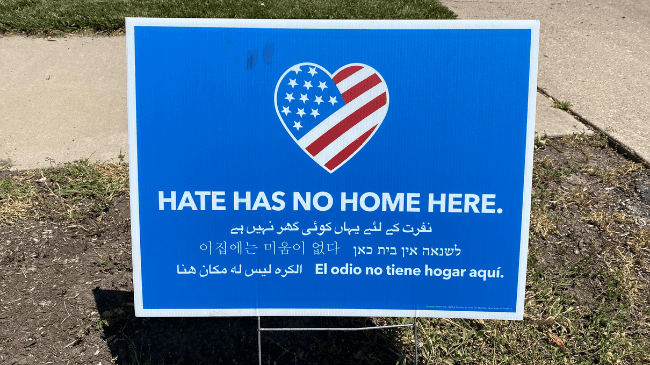
Ways to Get Started
1. Look Up Your Elected Officials
First, you can start by learning about your elected officials. Who are they? What are the issues they care about? If you are in Illinois, you can click here to search for your elected officials and use your address to find a list of people at a local, state, and federal level. In Chicago, you may also want to click here to find your ward’s alderman. Or if you are outside of Illinois, visit this page on USA.gov for help identifying your elected officials in other states.
Because these are the people you will call to share your perspective, write letters to, and reach out to for meetings, it’s a good idea to know who they are, what their focus areas are, and how you can engage.
2. Learn About the Issues Impacting Immigrants and Refugees in Your Neighborhood
If you are not an immigrant or refugee yourself, one of your first actions should be to learn more about the experience of immigrants in your community. Talking with your neighbors or others in your church or school communities can provide all kinds of insight! Ask them questions based on their own experience and what they think would make their lives better. And try talking to lots of different people to identify common themes. Don’t assume that there is only one “right” answer.
Reading and watching videos is another great way to learn! You can find all kinds of stories and helpful information from reading the World Relief Chicagoland blog. But don’t stop there! In addition to learning about the experiences specific to immigrants and refugees, (many of the biggest issues that impact them affect a broader group of people…such as people of color, religious or ethnic minorities, or low-income families), consider looking up issues like:
- Does your town have enough affordable housing?
- Are there sufficient healthcare and mental health resources?
- Do the schools in your area have enough teachers and educational supplies?
3. Take Note
As you learn, pay attention to the solutions that trusted leaders share. Organizations like World Relief are part of community coalitions and networks that share information and work to identify good solutions together. But there are plenty of experts in your community too. Take the time to ask your immigrant neighbors, organization leaders, and others what they think needs to change. And take note of what they say!
4. Mobilize
There are so many different ways you can mobilize your community to take action. Here are just a few ideas!
- Join Refugee Council USA (RCUSA) Advocacy Days. World Relief is part of RCUSA, which hosts advocacy days each year. These advocacy days bring together community members and organizations in support of refugee issues. When you sign up, you get to participate in training opportunities and meetings with members of Congress! You will get to join a facilitator and others in your community who care about refugees. Invite your friends and neighbors to join too by posting about these opportunities on social media.
- Attend city council meetings, school board meetings, and neighborhood council meetings in your area. Show up and pay attention to meetings where big decisions impacting your community are made. Additionally, you can use the information you have learned to inform your questions and bring refugee and immigrant issues to the forefront of the conversation.
- Lastly, learn more about World Relief Chicagoland’s advocacy efforts and how you can get involved!
Read More About How to Address Barriers
How the Affordable Housing Crisis Is Impacting Refugee Families
How to “Drive” Change by Donating Your Car
4 Ways to Read, Watch, and Listen to Powerful Immigrant and Refugee Stories
5 Times in U.S. History When Christians Advocated for Refugees and Immigrants
This year, the number of displaced people reached 100 million. That includes refugees, asylum seekers, and 53.2 million people displaced within their home country by conflict. And it’s a higher number than ever recorded in history.
In light of this, World Relief and other organizations have called for action – by the U.S. Government, community members, and the Church. Christian leaders are at the forefront of this advocacy, motivated by verses like Matthew 25:31-40.
“I was hungry and you gave me food, I was thirsty and you gave me drink, I was a stranger and you welcomed me.”
Matthew 25:31-40, in which Jesus tells His followers that caring for others is a way to serve Him directly.
A History of Welcoming the Stranger
The crisis may be greater than ever before, but throughout history, Christians have spoken up about immigrant and refugee needs.
In recent U.S. history, Christians have referenced Deuteronomy 24:14 as a moral reason to look out for the good of immigrants: “Do not take advantage of a hired worker who is poor and needy, whether that worker is a fellow Israelite or a foreigner residing in one of your towns.”
This Scripture has inspired countless people of faith to seek justice and care for immigrants navigating a foreign culture in the United States.
At times of prevalent anti-immigrant narratives, Christians have returned to the Bible’s command to care for immigrants and refugees. At times when the Church forgot its mandate, bold leaders reminded the Church of this biblical calling.
Here are 5 Times in History When Christians Led in Advocating for Immigrants and Refugees.
Advocating for Chinese Immigrants
In the 1840s and ‘50s, work in the California gold mines and garment factories, agricultural fields, and railroads drew thousands of Chinese immigrants to the U.S. West Coast. Eventually, more than 25,000 Chinese immigrants became the state’s largest non-white minority group. They formed vibrant communities in California. But despite being only .0002% of workers in the U.S., anti-Chinese sentiment began to grow, as white workers blamed them for taking jobs and depressing wages. Chinese immigrants faced growing discrimination, exclusion from community, and new anti-Chinese legislation. Eventually, the Chinese Exclusion Act of 1882 restricted Chinese people from migrating to the United States.
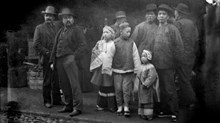
During this time, a Presbyterian pastor and missionary named William Speer became a vocal advocate for the fair treatment of Chinese immigrants. He used his relationships, knowledge of their language, and workforce data to argue against anti-Chinese legislation and even planted a Chinese Christian church in San Francisco in 1853. During his lifetime, he was vocal in opposition to racial prejudice and left a legacy of successors who contributed to fighting the racist anti-Chinese sentiment and joined with Chinese Christians to lead and channel Presbyterian support for the community.
Supporting Immigrants in the Community
At the turn of the 20th century, immigration to the U.S. ballooned. While conflicts and poverty pushed some immigrants to leave their home countries, the promise of jobs and economic opportunity drew others to the United States. Between 1880 and 1920, more than 20 million immigrants arrived – the majority from Southern, Eastern and Central Europe, including 4 million Italians and 2 million Jews. Unfortunately, many Protestants responded by working to restrict immigration and limit who could come to the United States (excluding Asians and other racial or ethnic groups) and promoting anti-Catholic messages and discrimination.

However, other Christians formed organizations and associations that helped immigrants integrate into the community. The YMCA in Cincinnati hosted the first known English as a Second Language (ESL) class in 1856 to help German immigrants gain language skill. Additionally, the YMCA served Asian communities in San Francisco. Then, in 1903, the YMCA created a specific department to work with industrial workers and immigrants, a legacy continued through to the YMCA’s present day adult education classes, refugee services, and New American Welcome Centers.
Welcoming World War II Survivors
By the end of the catastrophic World War II, millions of people were displaced throughout Europe or within their home countries. Many returned to their countries of origin within a few months of the war’s end. But for others, their home countries were irrevocably changed or unwelcoming. Among these were Jewish Holocaust survivors, many of whom spent years living in displaced persons camps alongside imprisoned Nazi perpetrators.
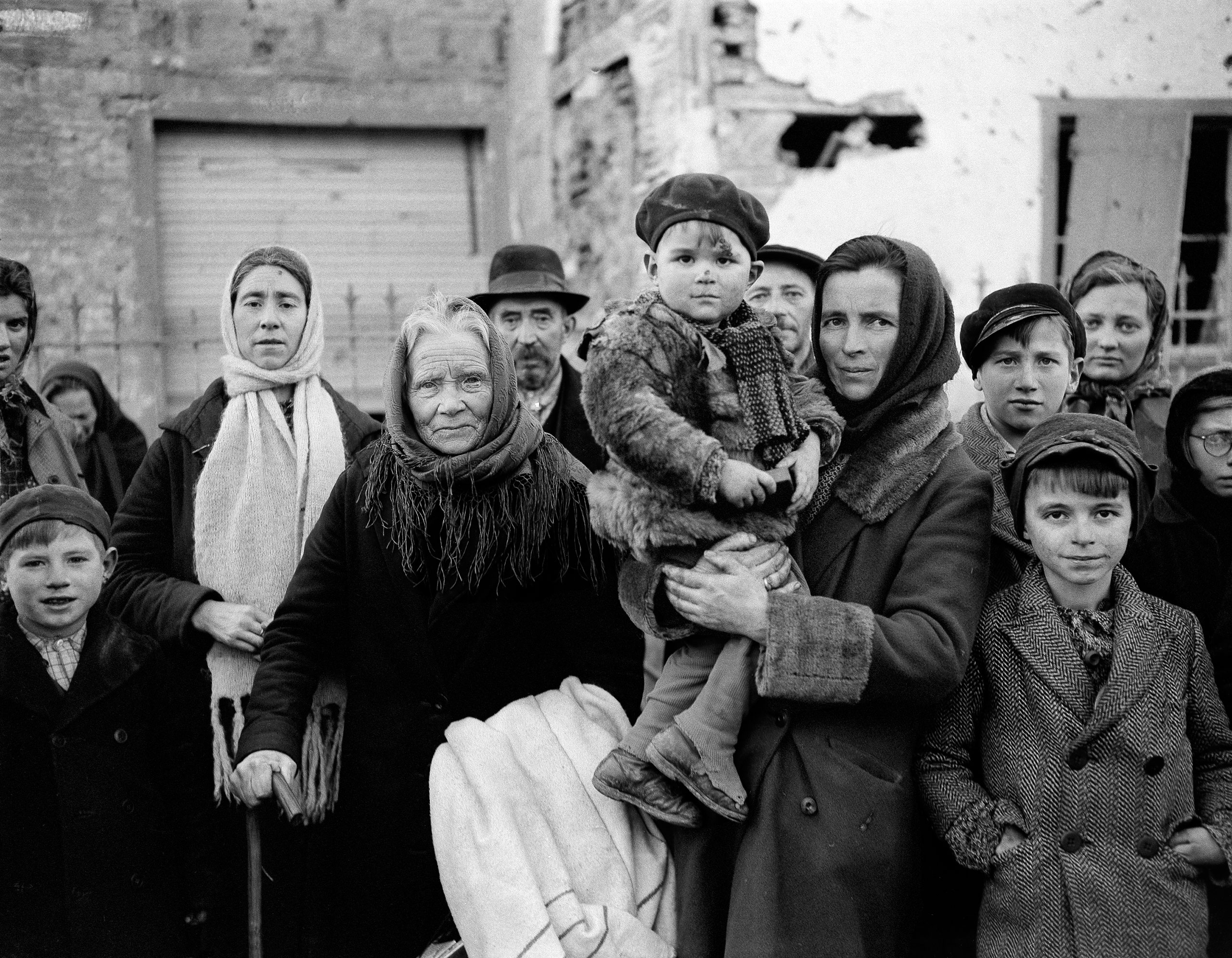
During this displacement, Catholic and Protestant congregations organized to respond. Christians joined with U.S. policymakers to convince American citizens to sponsor refugees. And while the U.S. Government created new resettlement legislation, Christian agencies and churches planned and implemented resettlement efforts, while also advocating before the government. In 1948, the United States passed the country’s first refugee and resettlement law. As a result, the government and Christian agencies partnered to help displaced Europeans seeking permanent residence in the United States after World War II. And to welcome the newcomers into community life.
Responding to Vietnamese Refugees
In 1965, the Immigration and Nationality Act fundamentally changed the American immigration system. Specifically, it removed quotes from the 1920s that had favored racial and ethnic groups over others and limited immigration from specific countries. The Act replaced them with a preference system that emphasized family reunification and skilled immigrants. In the next five years, immigration from countries torn by conflict, such as Cambodia and Vietnam, quadrupled. During this time, particularly from the 1950s until 1980, the U.S. Government’s refugee resettlement program was inconsistent, and the U.S. did not invest in refugee assistance. However, churches and faith-based organizations stepped up to fill in the gaps and help refugees get their footing.
Sometimes, this was done reluctantly. After two decades of conflict in Vietnam ended in 1975, 2 million Vietnamese people had been killed, 3 million were wounded, and 12 million had become refugees. In response, a woman named Evelyn Mangham emerged to call the Church to welcome Vietnamese refugees. With 20 years of experience as a missionary, Evelyn Mangham cold-called churches. She quoted the Bible. And she told stories. Because of her commitment to the Church and Scripture, she worked tirelessly to convince churches to sponsor refugees from Vietnam.
In the span of a year, she had convinced churches to sponsor 10,000 refugees from Vietnam, Laos, and Cambodia.
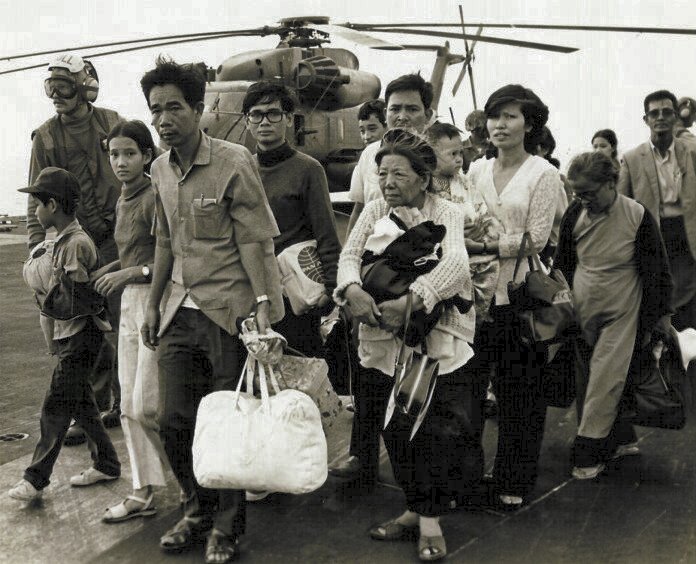
Founding World Relief
Ultimately, Evelyn Mangham went on to found World Relief’s refugee resettlement program alongside her husband, Thomas Grady Mangham, Jr.
We can thank this woman’s tenacity and conviction for World Relief’s 40-year history of refugee resettlement. And the impact continues today! All because Evelyn Mangham read Scripture and responded, believing that the Church must welcome the stranger.
“Her impact on the lives of those who are vulnerable will be felt for generations to come… I know there was a huge celebration for her in heaven as so many people whose lives she touched welcomed her to her eternal home.”
Jenny Yang, World Relief’s VP of Advocacy
Providing Safe Haven for Asylum Seekers
In the 1980s, nearly a million people fled Central American countries, crossing the U.S. border to seek asylum. Civil war and violence pushed people to leave home in El Salvador and Guatemala to seek safety. Yet a tiny fraction of those who crossed Mexico to the southwestern United States were approved for asylum.
The change came when Christians, alongside Jewish and other faith leaders, advocated on behalf of these migrants. The Sanctuary Movement began in 1980 with a goal: to provide shelters to Central American refugees fleeing civil wars. For instance, churches provided English lessons, basic humanitarian help, and legal aid through immigration attorneys. Additionally, leaders preached sermons, organized protests, and advocated to the government on behalf of the asylum seekers. And hundreds of religious communities provided sanctuary, usually inside houses of worship.
At its height, the movement grew to include more than 500 congregations.

Consequently, the Sanctuary Movement was successfully pushing the Reagan administration to pass the Immigration Reform and Control Act of 1986. This landmark piece of legislation extended temporary worker visa programs and helped 3 million people gain legal status.
Recent History
Today, there are nine agencies that work with the U.S. Government to resettle refugees. World Relief is one of them, along with five other faith-based organizations. One is Jewish, one is Catholic, and three others are Protestant. World Relief invites churches and Christians as a whole to welcome refugees and serve immigrants in the community – regardless of the religion, ethnicity, or country of origin of the newcomers.
As these five examples show, Christians have often been on the front lines of serving immigrants and refugees. Together, they have shaped history and the future of the country. Through action in faith, the Church has moved.
Today, Christians have another opportunity to act. And it’s at a pivotal time. Just like Christians throughout U.S. history, those who join World Relief are motivated by faith. And like Christians in the past, we have a calling. In response to a crisis, we can move together. Because of our faith and in light of the need, we can love our neighbors as Christ loves us.
And we can welcome the stranger.
A Refugee Family’s Long Resettlement Journey
For refugees seeking to rebuild their lives, their journey to the United States can be long and fraught with challenges. While the average time it takes for a refugee to be vetted and screened to come to the U.S. is about two years, many people leave their homes long before. UNHCR reports that some refugees who flee crises in their home country end up living in refugee camps for years or even decades. However, the vast majority of refugees live in cities, where they may live in limbo for 10 to 26 years, often with limited job and educational opportunities. Nobody wants to become a refugee. And most hope and pray to return to their home country someday.
When that’s not possible, it’s important that countries like the United States welcome refugees and provide a way for them to rebuild their lives permanently. But while their arrival in the U.S. is a cause of celebration, refugees have not yet reached the end of their journey. Coming to the U.S. sets refugees down a new road full of obstacles and barriers they must overcome in order to thrive in their new country.
World Relief’s job is to help the community be a place of welcome for refugees so that they can overcome these challenges and truly celebrate belonging and making a new home. Learn more about how you can walk this path with new arrivals by going on the journey of a refugee family below.
First Day of a Refugee Journey in the U.S.
Behind the Scenes

Even before a refugee family arrives, World Relief staff and volunteers from a local church or community group begin preparation for their arrival. Together, they move furniture and essentials into an apartment so that the family has what they need to feel comfortable and at home. By the time a refugee family arrives, they will have a home equipped with beds, a kitchen table, chairs, a couch, other furniture, and kitchen utensils. Volunteers like you also stock the pantry with familiar foods, coffee or tea, and cooking essentials. This helps provide a safe and welcoming place for a family to rest after their travels.
Arrival
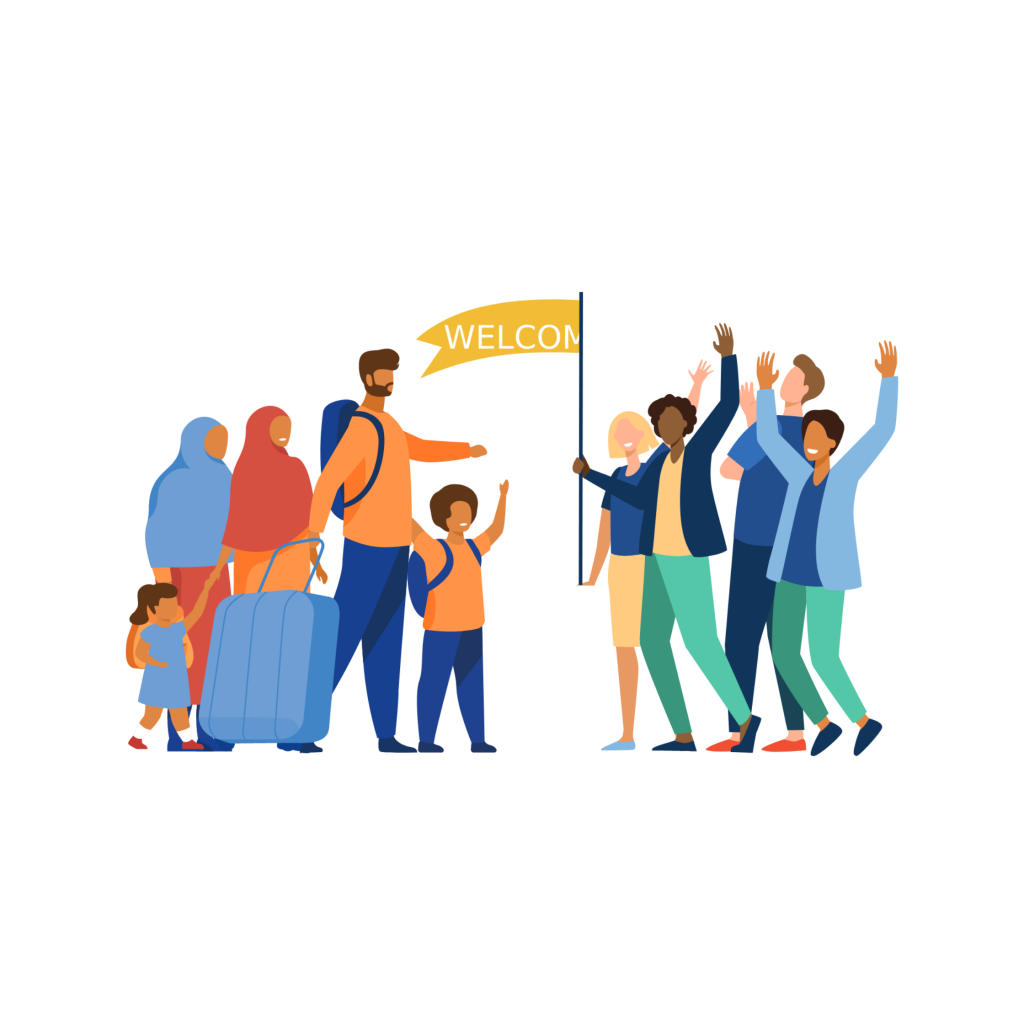
When a family or individual arrives to the United States, they often bring with them hopes and big dreams for the future. They are still mourning the lives and loved ones they left behind, but they also have expectations and goals for life in the U.S. From the time their plane lands at the airport, World Relief staff and people like you are there to welcome them and drive them to their new home.
First Week
Orientation to the U.S.
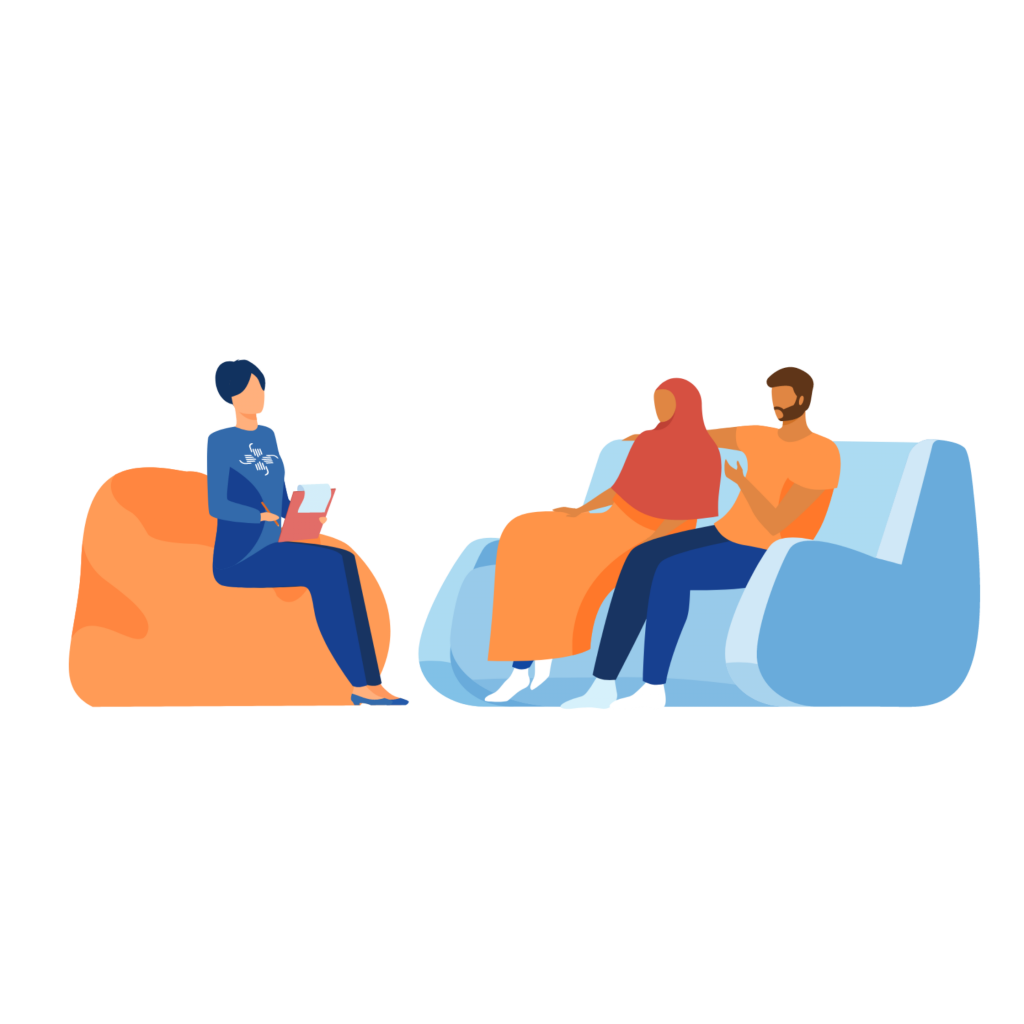
After a few days, the family sits down with World Relief staff and a Good Neighbor Team, a group of committed volunteers from the community who commit to supporting the family for the next six months. Together, they create an action plan to guide the family for the upcoming weeks as they settle in. The family and volunteers share with the family about the community and things they need to know.
First Month
Adjusting to the New Community
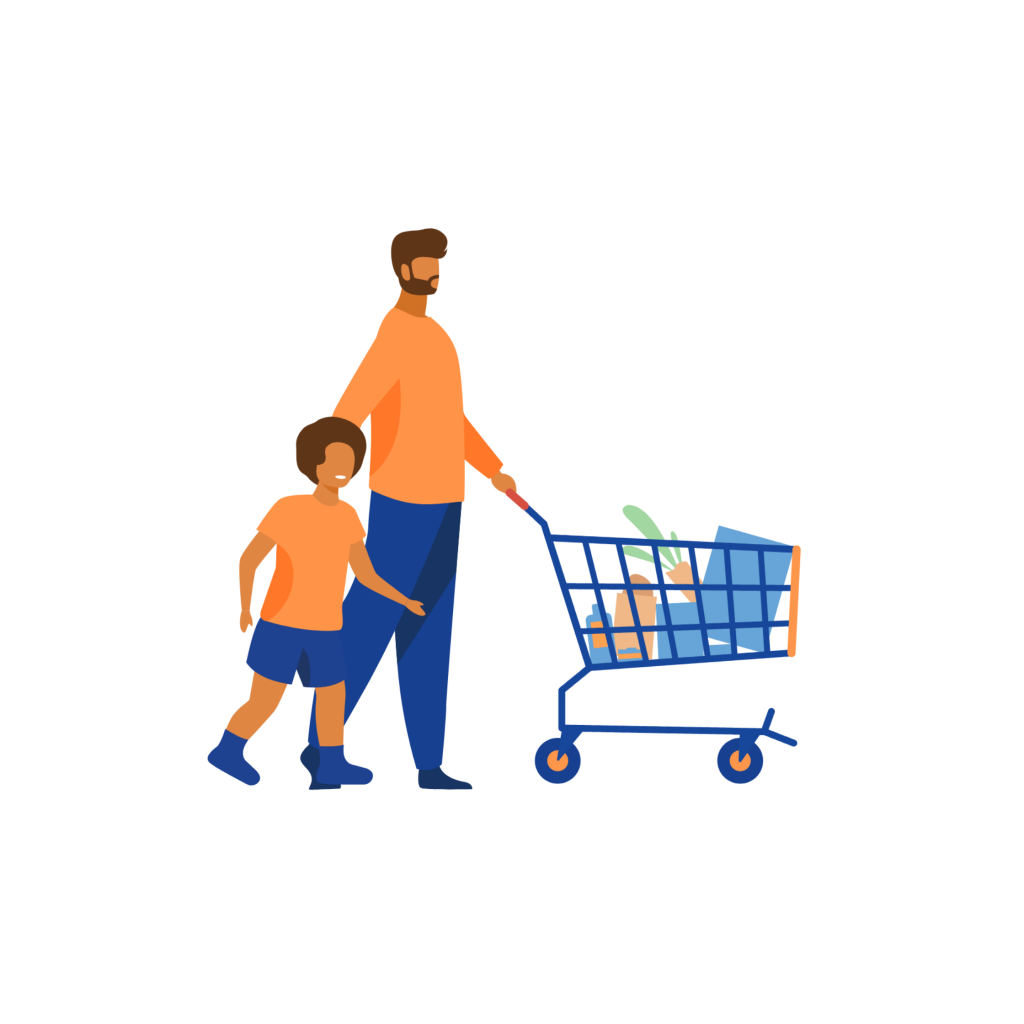
For the next few weeks, the family stays busy. There are errands to run. Doctors appointments to go to. Lots of paperwork. And there are many little tasks to do…everything from applying for social security cards to enrolling children in school.
First Three Months
Support for Children and Youth
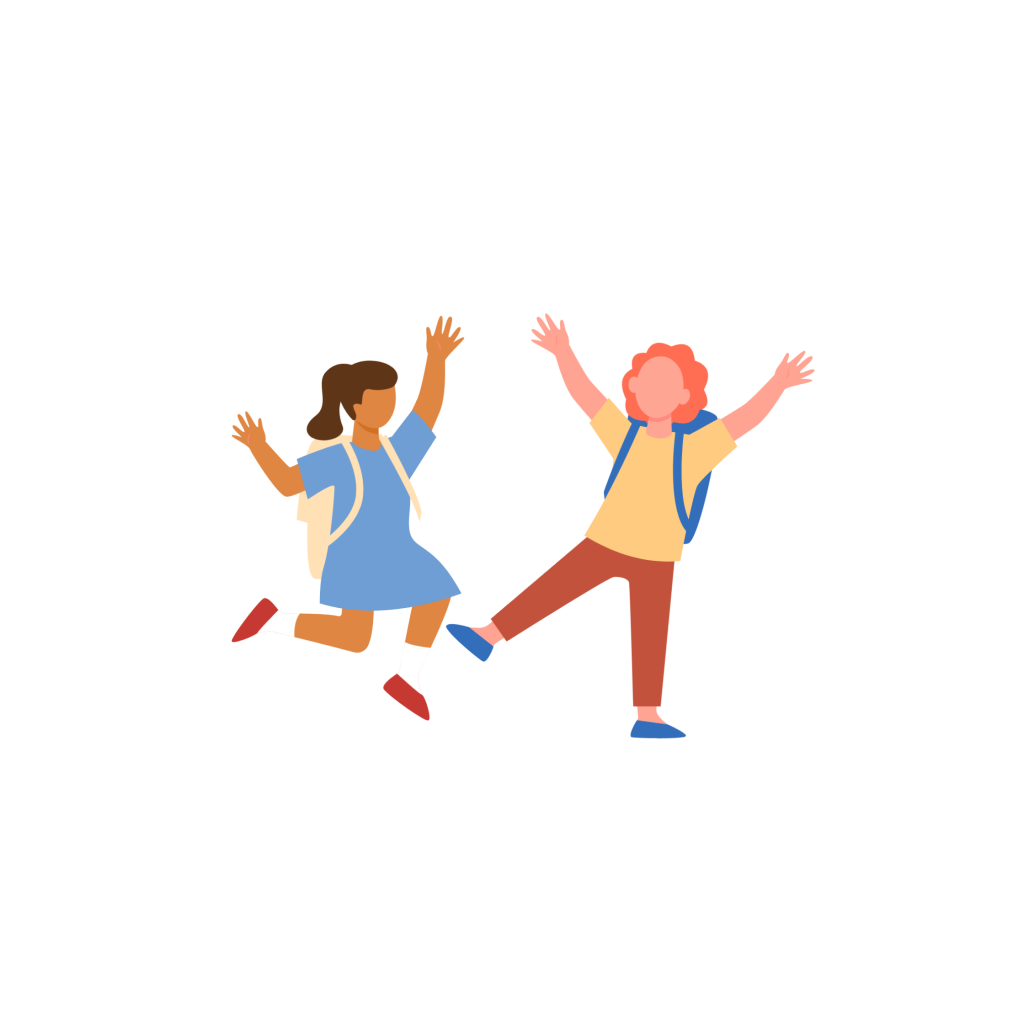
As the family adjusts, the kids get to participate in World Relief’s after-school clubs. There, they get homework help, play games, and meet other children. Social-emotional learning (SEL) activities help the children and youth process their emotions and build self-confidence. They learn and play alongside other children and practice important life skills like relationship-building and conflict resolution. And they get academic support from people like you so they can succeed in school!
Learning English
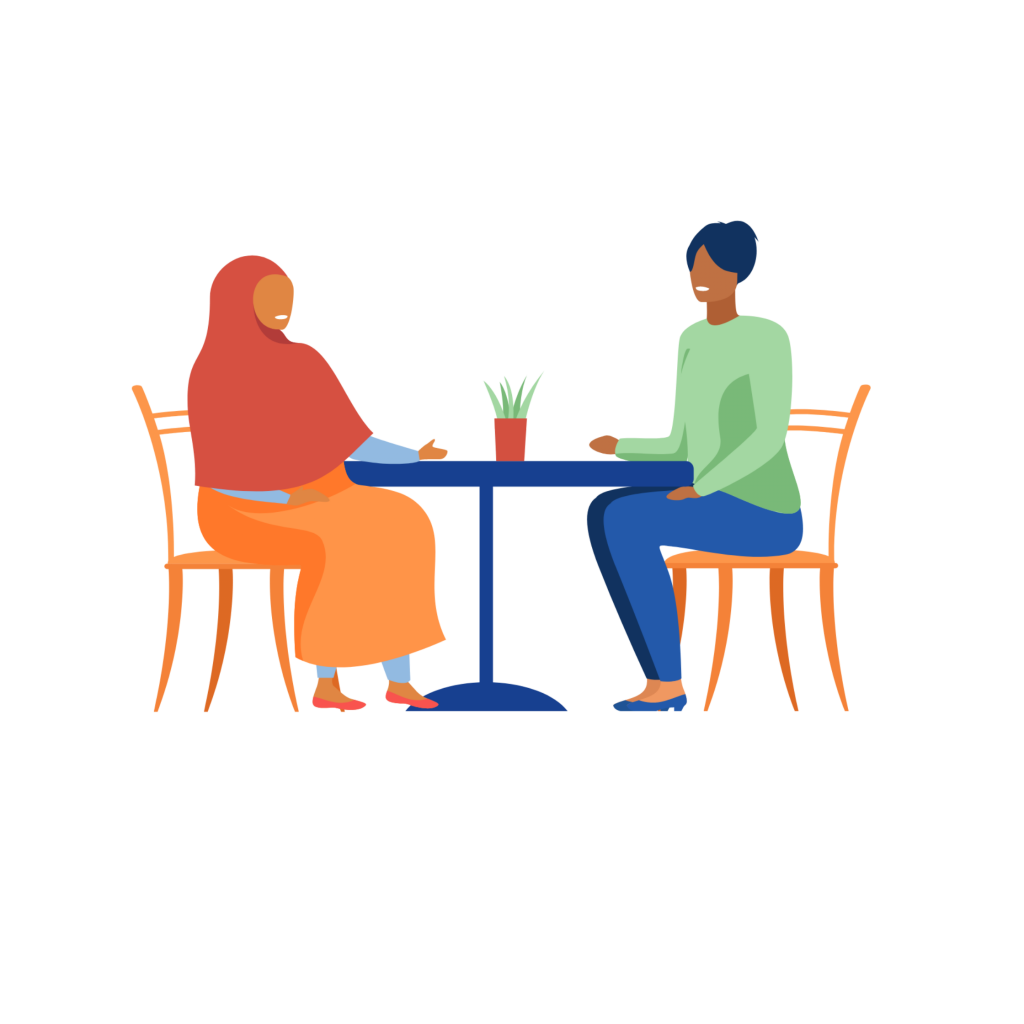
The parents join English classes. There, World Relief teachers, volunteers, and other English learners come together to practice their skills speaking. The family checks out an iPad from the technology lending library, which they use to do English homework and join classes on Zoom. Conversation cafes give language learners the chance to practice their conversational English by talking with community volunteers like you.
Starting New Jobs

Local business partners help the parents start new jobs, and World Relief’s Employment Services team helps them prepare for their new roles and start work. Later on, the Refugee Career Pathways team will help them brainstorm their long-term career goals and develop job skills.
First Year
Immigration Processes

Eventually, the family will apply for Green Cards so they can stay in the U.S. permanently. They gain the help of a World Relief staff attorney who helps them take this important next step – gathering documentation, filing paperwork, and completing all necessary steps. With affordable, qualified legal help and interpretation, the family does not have to worry about their legal pathway to become permanent residents or citizens.
First Five Years
Community Engagement
After a few years, Mom Sarya gets involved in the community. She joins a parent committee at her daughter Jamila’s school. Along with the other parents, she gets to support her daughter’s teachers and help create a welcoming environment for all students.
Saving for Long-Term Goals
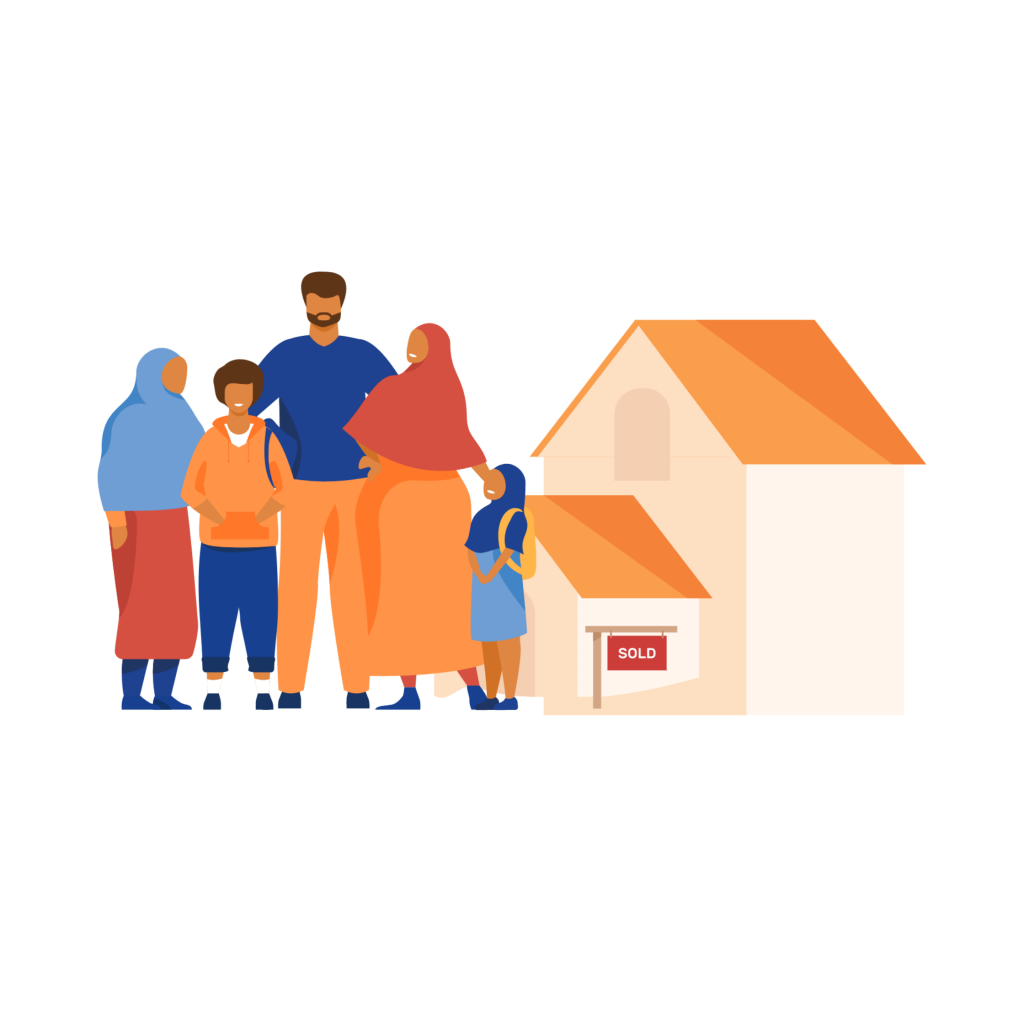
When the Ahmadi family joins the World Relief’s financial literacy program, they start learning how to manage money. They learn about debt, credit, and banking. Eventually, they join a match savings program and start saving money for a home. After a few years of diligent savings, they reach $4,000 and a partner matches their money dollar-for-dollar! They end up with a total of $8,000 – enough for a down payment on a house! Buying a home is a proud accomplishment for the family and a testament to their hard work.
Five Years and Beyond
Reaching Milestones
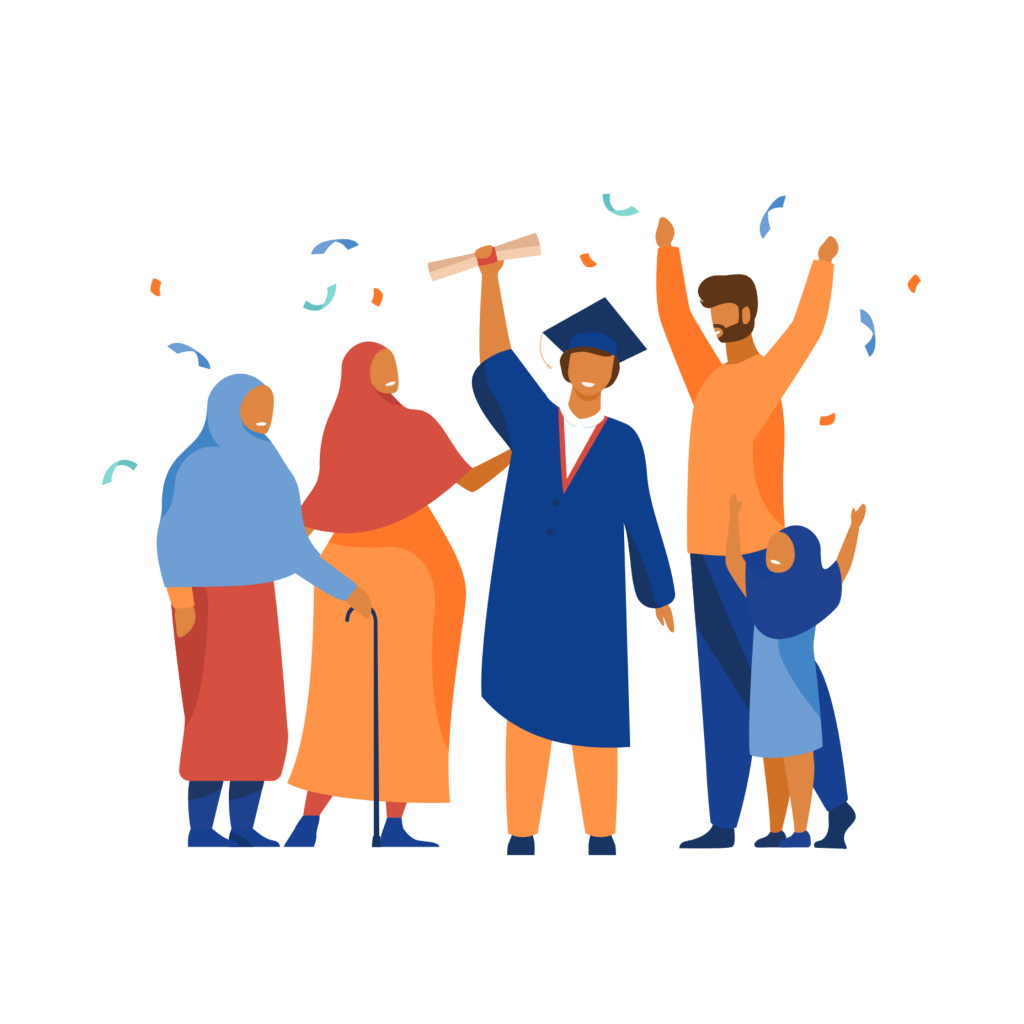
Eventually, the family becomes an integral part of their new community. As they achieve milestones in their careers, education, and personal lives, they celebrate! And we celebrate with them. For years to come, they continue progressing towards long-term goals and building relationships in the community.
Best of all, they move from being welcomed to being “welcomers” and they support other new arrivals on their refugee journey to belonging, just as people like you supported them.
Your Part in Their Journey
It is because of dedicated and compassionate people like you that families like the Ahmadis are able to rebuild their lives in a welcoming community. To find out how you can journey with families today, consider volunteering or becoming a monthly partner by joining the Path.
Read More Refugee Journey Stories
Ali’s Story: A Refugee Pharmacist Using His Career to Give Back to Others
Photo Essay: The Afghan Seamstress Sewing Beautiful Garments in Her New Community
Finally, I’m Home: Raphael’s Story of 8 Years Waiting for Resettlement

